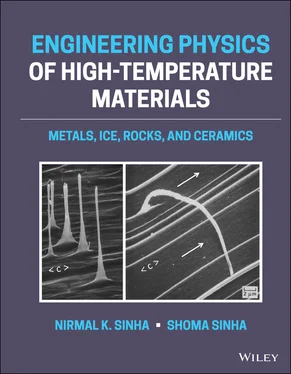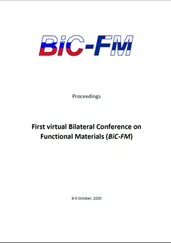2 Nature of Crystalline Substances for Engineering Applications
CHAPTER MENU
1 2.1 Basic Materials Classification
2 2.2 Solid‐state Materials 2.2.1 Structure of Crystalline Solids 2.2.2 Structure of Amorphous Solids
3 2.3 General Physical Principles2.3.1 Solidification of Materials 2.3.2 Phase Diagrams 2.3.3 Crystal Imperfections
4 2.4 Glass and Glassy Phase 2.4.1 Glass Transition 2.4.2 Structure of Real Glass 2.4.3 Composition of Standard Glass 2.4.4 Thermal Tempering 2.4.5 Material Characteristics
5 2.5 Rocks: The Most Abundant Natural Polycrystalline Material 2.5.1 Sedimentary Rocks 2.5.2 Metamorphic Rocks 2.5.3 Igneous Rocks
6 2.6 Ice: The Second Most Abundant Natural Polycrystalline Material
7 2.7 Ceramics
8 2.8 Metals and Alloys 2.8.1 Iron‐base Alloys 2.8.2 Nickel‐base Alloys 2.8.3 Titanium‐base Alloys 2.8.4 Mechanical Metallurgy
9 2.9 Classification of Solids Based on Mechanical Response at High Temperatures References
The study of materials is a fascinating and diverse subject matter! Knowledge of some of the fundamental concepts of materials science is essential to understand more complex discussions. This chapter focuses on some of the basic concepts of crystalline materials – i.e. from phases and crystallography to a basic understanding of solid material properties. We do not attempt to cover all the intricacies of materials science, but rather provide a foundation of knowledge for the subsequent chapters of this book.
MORPHOLOGICAL
PHYSICAL
CHEMICAL
The properties of solid materials can largely be grouped as: (i) morphological, (ii) physical, and (iii) chemical. The physical and chemical properties are themselves highly connected to the morphological properties – the external form and internal structure of the material. The intelligent design of new materials thus depends on an understanding of the structure–composition–property relationships, as well as the synthesis and processes required to obtain desired forms.
The process of understanding materials starts with gaining some insight into their structure. The structure of materials can be viewed at multiple different levels, which are as follows:
The subatomic level: Deals with the electronic structure of individual atoms and defines the interaction between them.
The atomic level: Deals with the arrangement of atoms in the material and can lead to hugely different properties.
The microscopic level: Deals with the arrangement of small sections or “grains” of material; it is the structure of a material at a magnification of 1–100 000 times, depending on the material, and thus generally discernible only with the use of optical and/or electron microscopy.
The macroscopic level: Deals with structural elements that can be viewed with the naked eye.
2.1 Basic Materials Classification
Trinity of Classification
POLYMERS
METALS
CERAMICS
To facilitate the understanding of matter, materials scientists often classify solid materials into three broad categories: polymers, metals, and ceramics. Composite materials are created by the combination of two or more base materials – often having different properties. Composites can thus be designed to have quite different properties than their constituent materials.
“Polymers” are large molecular or macromolecular materials composed of repeating subunits. In this overarching classification strategy, polymers include not only commercial plastics but also materials, such as deoxyribonucleic acid, proteins, wood, skin, hair, and others. The primary bonding structure of polymers largely consists of covalent bonds ; that is, valence electrons are shared between the bonding atoms. Covalent bonds are characterized by small electronegativity (ability of an atom to attract electrons in a bond) differences and low electron mobility. Secondary bonding, the attraction between atoms of different molecules or between different parts of the same polymer, can play a strong role in the structure and properties of polymers.
“Metals” are typically lustrous, opaque, and ductile and have good electrical and thermal conductivity. They can be composed of a single element and, in fact, approximately 91 of the 118 elements in the periodic table are classified as metals. Metallic alloys are metals composed of one primary or base metal and one or more metals, or nonmetal element. For example, the alloys used in making components of various stages of gas turbine engines are based on four primary metals: iron, titanium, cobalt, and nickel. Superalloys are high‐performance alloys that are most often resistant to high temperatures. Metallic bonding is characterized by small electronegativity differences and high valence electron mobility. Metallic bonding is often pictured as positive metal ions in a “sea” of electrons.
“Ceramics” are inorganic materials primarily held in covalent or ionic bonds. Ionic bonds are characterized by high electronegativity differences and thus one atom in the bond has a much greater attraction for valence electrons resulting in two oppositely charged ions. As the electrons are strongly attracted to one ion in the bond, they have low mobility, and such materials generally have low conductivities. Ceramics include not only pottery or fired clay products, but also cement, bricks, glass, salts, and other minerals.
Some knowledge, even at the rudimentary level, of minerals is also necessary for materials scientists and engineers, including geologists, metallurgists, chemists, and physicists. A “mineral” may simply be defined as a naturally occurring inorganic substance that is chemically homogeneous and has an ordered internal structure. Common mineral groups include silicates, oxides, sulfates, sulfides, carbonates, halides, and the native elements. The rocks of Earth's crust, lithosphere, and – to some extent – asthenosphere consist of units that are essentially minerals with wide‐ranging chemical and physical properties.
While the basic trinity of classification is one of the primary ways in which materials classification is accomplished, other methods of grouping materials have evolved to support research and development in specific fields. For example, although not generally explored in the traditional basic trinity of materials classification, “semiconductors” are an important classification in our modern age. As the name implies, semiconductors are classified largely based on their electronic properties. In a semiconducting material, the electrical conductivity falls between that of a conductor (metal) and an insulator. Semiconductors are typically characterized as having covalent bonding. Traditional semiconductors include elements (also termed metalloids) like silicon and compounds like gallium arsenide, but semiconducting properties are also being designed into polymers and ceramics.
GAS
LIQUID
SOLID
Materials consisting of single elements or compounds can exist in three well‐defined physical states: gas, liquid, and solid. These states depend on temperature and pressure.
A “gas” is a state of matter in which the atoms or molecules are separated by a large distance. Molecules in the gaseous state vibrate and move freely to occupy the volume made available. A related term is “vapor,” which technically refers to a material that is in the gaseous state at conditions in which it can also exist in the liquid or solid state (i.e. below its critical temperature, described further later in the text). Often, the terms “vapor” and “gas” are used synonymously.
A “liquid” is, in general, a condensed state of matter in which the particles are irregularly spaced (or, in other words, there is no long‐range order); that is, they are amorphous in nature. Unlike gases, liquids are generally not easily compressible; however, they flow easily.
Читать дальше












